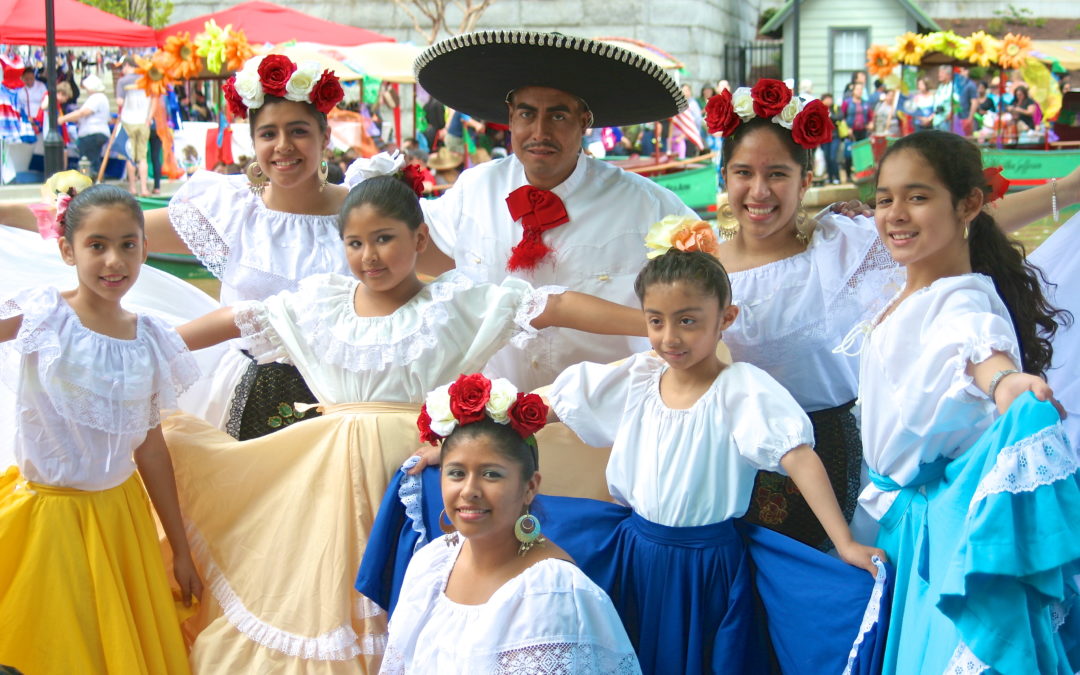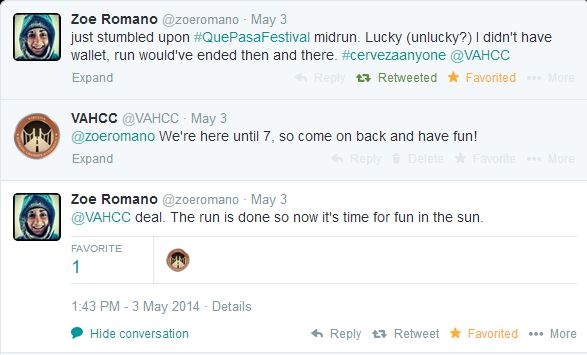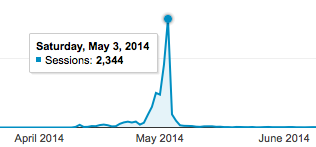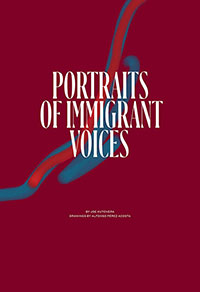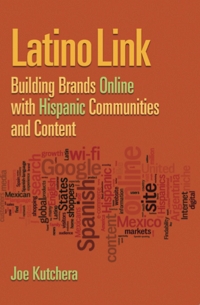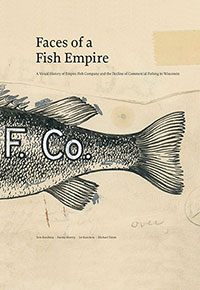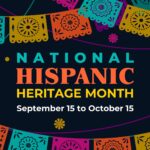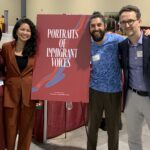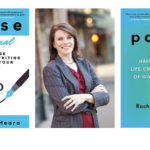Following is the case study of a recent project that I worked on involving how to develop and implement a social media strategy for events and festivals.
BACKGROUND
The Virginia Hispanic Chamber of Commerce (VAHCC), a Richmond-based non-profit, creates, promotes and enhances business opportunities for Hispanic-owned businesses as well as facilitates connections for companies to the Hispanic community. The VAHCC hosts the annual Que Pasa Festival annually to celebrate the food, music, and art of Virginia’s Latin American communities.
The Que Pasa Festival takes place on the first weekend of May, in honor of Cinco de Mayo, along the Canal Walk in downtown Richmond. The VAHCC invites Latin musicians, dancers, vendors, and artisans to participate in The Que Pasa Festival in order to highlight the growing importance and presence of Latino culture and businesses in the Richmond area.
MARKETING OBJECTIVES
The VAHCC asked us to accomplish three goals:
- Create social media conversations as well as increase media coverage of the Que Pasa Festival
- Grow attendance (around 3,000 people attended the event in 2013)
- Deliver media value to sponsors via social/online media
CHALLENGES
We faced three major challenges:
One, the Que Pasa Festival did not have a website. (At the time, the Que Pasa Festival only had one page dedicated to it within the VAHCC website, so the information was hard to find.) We needed to put together a content and navigation plan for a new website as well as design and develop it.
Two, the VAHCC had not actively listened to or engaged its members or fans on social media previously. Prior to the 2014 Que Pasa Festival, the majority of the VAHCC’s posts on Twitter and Facebook were automatically generated from Constant Contact newsletters. With such a large public event on the horizon, we needed to significantly boost the VAHCC’s social media presence in order to gain attention and interest. We did that through listening to our influencers and readers online.
Three, the 2014 Que Pasa Festival coincided with two major events that same day: the French Food Festival as well as the CapTech USA Cycling Collegiate Road Nationals. The cycling competition brought thousands of bicyclists from across the country into downtown Richmond, which closed off many streets for the bike race throughout downtown. This limited attendees parking options as well as made access to the festival more difficult. As a result, this required us to utilize the website, social media and VAHCC’s email newsletters to get the word out about how to best arrive to the festival.
TARGET AUDIENCES and INFLUENCERS
Before determining our communications and marketing message, we wanted to understand who to direct our message towards and their needs.
We aimed to reach a broad spectrum of potential attendees: the local Hispanic community and anyone who lived within a 30-mile radius of Richmond interested in Latin cuisine as well as salsa music and dancing. In order to reach this audience, we aimed to communicate with community “influencers” and the local media as that would have the most impact.
We created a database of our six target influencer audiences in order to organize and rank those people and organizations that we wanted to communicate with, including:
- Local newspapers, blogs, magazines, radio, and TV stations
- Richmond-based TV and media personalities
- Richmond food bloggers and influencers
- Corporate sponsors
- Local breweries and Richmond-based companies
- Vendors and performers participating in the festival
We ranked each influencer and organization/company by the number of followers they had. Then, we added their contact information and social media handles in our database. This enabled us to quickly assess the importance of each influencer or organization that we reached out to. Our database provided VAHCC not only with a list of key contacts to reach out to for the 2014 Que Pasa Festival but it also served as a database for all future events.
SOCIAL MEDIA and WEBSITE CONTENT STRATEGY
Once we identified our influencers and their perspective, our content strategy came into focus. This included three approaches:
First, we knew that if we could engage the local media, TV/radio personalities, bloggers, and our sponsors to talk about the event, then that would encourage other Richmonders to attend the festival. Community-based news organizations such as Richmond.com, Style Weekly, and RVANews.com have a strong following because they consistently provide their readers with information about fun events around town. For example, we invited local radio personalities to emcee one of the stages and in return they promoted Que Pasa Festival on the air.
Two, we wanted to express gratitude to the VAHCC’s corporate sponsors of the event as well as provide them with added exposure. They included Dominion, MWV, Altria, Riunite, Bank of America, Wells Fargo, Bon Secours, Nationwide, StateFarm, and T-Mobile. One simple yet effective element of our content strategy for social media simply included saying “thank you” to each of our sponsors on social media for their sponsorship of the event and then including a video from last year’s festival to show how fun it was. Some of these companies retweeted or liked those posts, thus increasing the visibility of our festival.
Three, the participating restaurants, musicians and dancers each have their own following, however small or large, online and offline. We wanted to tap into that and leverage their interest in making the event a joint success. We planned to showcase their participation in social media, giving each one of them a “shout out.” In return, we hoped they would re-tweet and further promote the event to their followers. Even though individually they may not have huge following, we knew that if we aggregated their followings collectively, we could create a groundswell of interest in the Que Pasa Festival. For example, Clara of Salsa4Life represents a great example in this category. She has a huge following and email database of people who love to dance salsa in the Richmond area. The VAHCC invited her to teach salsa dancing classes during the festival so we knew we wanted to engage her and people like her to encourage their fans to join in the fun at the festival. Another examples includes the local breweries which elicit a great deal of pride in Richmond. We chose to feature 5 local craft breweries at the festival this year and talk that feature up on social media. It worked tremendously well as the tap beer sold out within four hours.
Most importantly, we launched a brand new website dedicated to the Que Pasa Festival including channels for the food, entertainment, artisans & vendors, about, sponsors, and how to “get involved.” This served as our content “hub,” that we could share wherever and whenever we needed to. We also added a dedicated Directions page about how to get to the event with all of the road closures that we shared across social media during the final days leading up to the event.
MARKETING SOLUTIONS: VIDEO and RSVP’s
OK, so we now clearly understood our objectives, challenges, target audience and influencers. How could we weave this information into a solid online marketing plan to cut through all of the noise and entice Richmonders to attend the Que Pasa Festival downtown (driving around all of the bike race detours)?
One, we knew from our research that video content received the most clicks on Facebook and Twitter, ranking well above text and photo-oriented content. We decided to utilize the following video summary of the 2013 festival to give attendees of this year’s event a preview of what to expect:
Two, the most powerful form of “advertising” isn’t us talking about ourselves. It is other people talking up the event via word of mouth and committing to attend the event online. As the well-known refrain states, “We have two ears and one mouth, so we should listen more than we say.”
So, we focused on a strategy of asking people to RSVP to our free event on Facebook for the sole reason that their friends would then see that they planned on attending. We created a Facebook event page called, “2014 Qué Pasa Festival of RVA – FREE” and invited over 2,100 people to RSVP on the event page. Four hundred and two people RSVP’ed on our Facebook page. As a result, if each person that RSVP’ed has 400 friends on average, then the 402 people who committed to attend the event transmitted that message to their 160,800 friends! That friend-to-friend messaging provided us with the most powerful exposure we could have asked for.
Three, to supplement our list of friends that we invited to RSVP on the Facebook page, we also bought advertising on Facebook that directed people to the event page, featuring the video and asked them to RSVP. In addition, we bought Google AdWords that directed people to our newly launched QuePasaFestival.com.
Four, listening played a crucial role in our social media promotion of the event. As discussed, the most powerful form of “advertising” isn’t us talking about ourselves, it is finding other people who were already excited about the event and then re-tweeting those mentions on Twitter, for example. We utilized HootSuite to monitor the mentions of our event across all social media platforms and then re-tweeted and favorited tweets mentioning the Que Pasa Festival.
Five, we reached out to all of the local media outlets through personalized emails asking them to include the event in their newspapers, on air, and on their blogs. We also reached out to them on Facebook and Twitter, mentioning them in messages on their respective pages while sharing the video, hoping that they would re-share it and also so that the fans of their page would see the video.
Six, in order to create positive “buzz” around the Que Pasa Festival, we needed to increase “findability” of the event. We utilized the hashtag #QuePasaRVA specifically for the festival and also the much more widely used hashtag #RVA (for Richmond, VA) on Twitter, Facebook and Instagram.
Lastly, during the event, Amanda Zack and I actively took pictures at the festival, posting them on Facebook, Twitter, and Instagram and also actively listened for mentions and feedback. We wanted to create content on social networks the day of the festival in order to generate interest from people to attend that were looking for something to do while perusing Facebook and Twitter. For example, Amanda interacted with a woman on Twitter who knew nothing about the Que Pasa Festival but stumbled upon it during her morning run and returned later with friends. Here’s a screen shot of our Twitter interaction:
RESULTS
Attendance
Over 5,000 people attended the event on a weekend where we faced significant competition from both the French Food Festival as well as the 2014 CapTech USA Cycling Collegiate Road Nationals, which caused significant road closures across the city of Richmond, VA. We utilized social media and our email newsletter database to let people about all of those road closures the day before and day of the event, so having 2,000 more people attend the annual festival than the year before was a major accomplishment considering the logistic challenges we faced that day.
Website Visitors
On an average day, the VAHCC website receives between 100 and 150 people per weekday and 40-50 people on Saturdays/Sundays. But in the days leading up the festival, the traffic took off. Between 200-300 people per day visited the VAHCC website, which then reached a peak of 877 people on the Saturday of the Que Pasa Festival. The VAHCC.com page dedicated to the event had a brief description and then led people to QuePasaFestival.com, which had even more staggering growth.
We launched QuePasaFestival.com in mid-April, only three weeks before the festival. The traffic started growing on April 28 with 278 visitors/day growing to 709 visitors on May 1, reaching a peak of 2,344 visitors on the day of the event, Saturday, May 3, 2014. Needless to say, we were thrilled that we had dedicated our time and resources for a stand-alone festival page that clearly and effectively provided users with the information about the event.
Media Mentions
We received numerous positive write ups prior to the festival including those on Style Weekly, local CBS affiliate station, WTVR, and on the popular weekly newsletter, RVA on the Cheap, all of which helped us attract attendees.
Subsequently, we shared those articles on Twitter and Facebook leading up to festival day.
Following the event, The Richmond Times-Dispatch wrote up this story about the annual festival: ¿Qué Pasa? celebrates Hispanic culture in Richmond.
Social Media Successes
We posted dozens of updates, invitations with our video as well as “thank yous” to participating sponsors and vendors in the weeks leading up to the big day. This generated a significant amount of conversation about the Que Pasa Festival across the three social networks where we posted including Twitter, Facebook and Instagram.
This yielded the following results during the event:
- On Twitter: More mentions about the event from our fans/attendees than we had posted ourselves; twice the number of re-tweets than the number of tweets we sent.
- On Facebook: More than three times the number of posts from other people than the number we had posted. Overall, 2,630 people saw the Facebook Que Pasa Festival page posts the day of the event.
- On Instagram: Nearly three times as many likes as photos posted.
Some of the user-generated content from the festival proved inspirational. Attendees like photographer Baramon Kolb Photography captured these beautiful photos on Facebook while “BobSun11” posted this video of “Boris and Marisol dancing cuban salsa” on YouTube.
In conclusion, attendees had a great time and sponsors were pleased with the results. Now, we have a website template as well as social media videos and photo galleries that we can utilize to promote our 2015 festival.
OUR TEAM
It was truly an honor to work with a great team, which included:
Joe Kutchera, Social Media Director
Amanda Zack, Social Media Manager
Michel Zajur, President of VAHCC
Kelly Padgett, Director of Marketing & Communications at VAHCC
David Parrish, Website developer at Kravid Interactive

